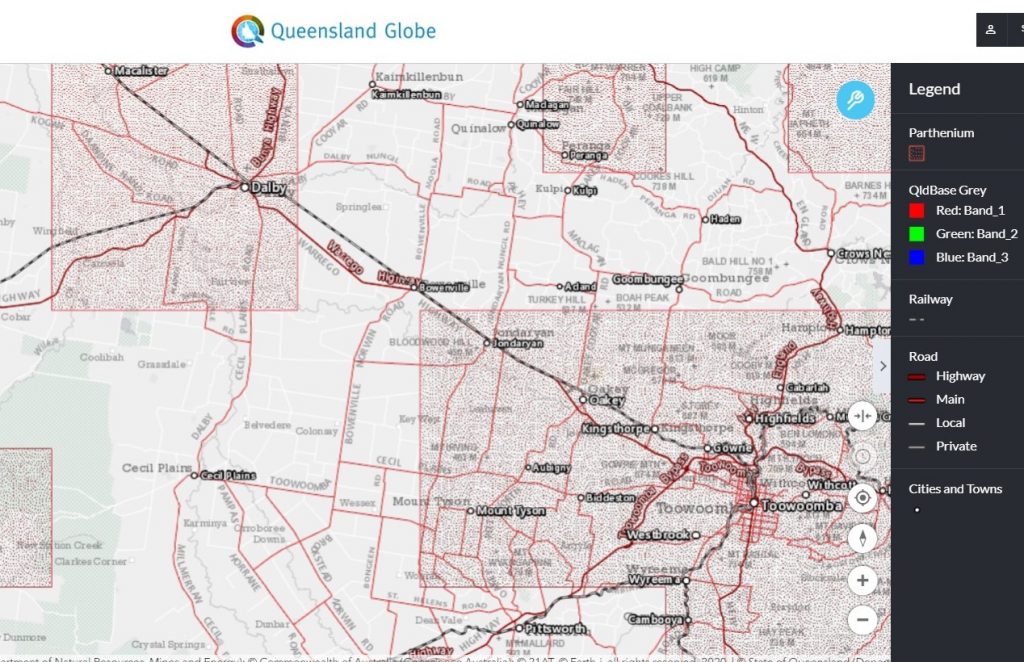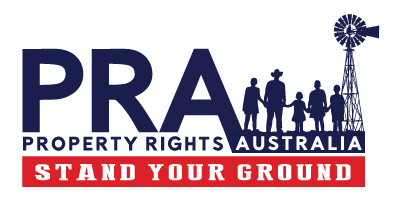In Queensland, the CSG industry’s promise to ‘minimize pests and to wash down vehicles that have been potentially in contact with pests when entering new ‘worksites’’ is not worth much. Being recognised as a Parthenium Free Area IS!
Farmers facing CSG development, and particularly those of the fertile and closely settled farming community around Cecil Plains are gravely concerned that the adaptive management approach that the government is taking to permitting the CSG industry will mean they will need to adapt to the presence of weeds of national significance.
“It is not just parthenium that is a concern,” Joanne Rea, Chair of Property Rights Australia (PRA) stated.
“Farmers carry the greatest obligation under the biosecurity act, and yet have the least input into how the CSG activities will be managed. When reading the industry, APPEA and local government documents on how this issue will be addressed they just make theoretical, generalised, aspirational and broad commitments. The CSG industry, the risk they represent, and how it is considered in planning and management is not even mentioned in the Toowoomba or Western Downs Regional Council Biosecurity Plans. The control measures are heavy on up front surveys. The landholder is not necessarily privy to these and the landholder will need to pay significantly to obtain their own baseline surveys pre gas industry if they wish to have some means of evidence if it were to be needed in a future dispute.”
Not much is said about how the CSG Industry will mitigate their contribution to weed and pest distribution, how they will prioritise the PREVENTION or incursion and how they will MAINTAIN the current status of the area as for example Parthenium Free.
“It is not reasonable or an effective methodology for the industry and the local councils to reduce the realities of the impacts for farmers to generic steps associated with individual farms “vehicle hygiene declarations” and individual and highly variable CCAs (Conduct and Compensation Agreement) with the neighbours excluded”, said Mrs Rea.
“The Gas Industry does not have a great track record to date regarding weeds and pests. What happens if an infestation does occur? How will it be dealt with? How will a farmer possibly be able to prove the industry as the source? Will a response be prompt, coordinated and transparent, or will it be convoluted and drawn out as has been the experience of host farmers concerning this and other CSG compliance issues?”
Mrs Rea summarises, “The farming community wants greater input and more transparent, measurable, monitored means of ensuring that weed and pest status will remain in its current level or better during these additional high risk activities. They want some control over what is done with the information obtained from their property by the companies. They want to be compensated for the additional time and costs incurred by having this industry that carries such high biosecurity risks, among others, move into their community and into their businesses.” ENDS
Further Briefing Notes
The farming community within a 20km radius of Cecil Plains (at least) has parthenium free status.

The Toowoomba and Western Downs Regional Council Biosecurity Plans (2020 and 2017 respectfully) do not mention the CSG Industry in any way.
The plans do encourage landholders to talk to neighbours and work cooperatively to manage the risks.
The landholders after all collectively hold the greatest responsibility and the greatest risk for biosecurity matters.
However, in the circumstances with the CSG industry the neighbour is systematically excluded from the engagement process.
In Arrow’s own Environmental Impact Statement (EIS) for the Surat Gas Project they admit the following:
Project activities have the potential to affect productivity and increase costs through reduced crop yields and losses, disturbance of farm animals, degraded soil structure and fertility, and increased management overheads. Potential impacts to agriculture…[include] …the introduction and spread of weeds and plant and animal pathogens.
Arrow’s project documentation, for example, identifies parthenium as a weed of national significance and that there are no known infestations in the project area (it is however current in many areas that they already work in and will be travelling from). However, there is very little practical or measurable means documented to ensure that the project area of Cecil Plains stays that way.
The EIS refer to Arrow’s procedures for vehicle hygiene inspections and weed management. It also refers to the Petroleum Industry – Pest Spread Minimisation Advisory Guide which has been endorsed by APPEA and developed in consultation with:
- Biosecurity Queensland, Department of Primary Industries and Fisheries (DPI&F)
- Local government
- Industry representatives
- Queensland Murray Darling Committee
- Australian Petroleum Production and Exploration Association (APPEA)
But NOT Host Landholders who bear the greatest responsibility and the greatest risk (individually and collectively) relating to this issue.
All of the industry referenced documents are academic in nature and are heavy on up front survey’s etc (to which the landholder is not necessarily privy and the landholder will need to pay significantly to obtain their own baseline surveys pre gas industry if they wish to have some means of evidence if it were to be needed in a future dispute). Post survey though, the industry then rely heavily on documented procedures and forms as the means of managing this issue.
Not much is said about how they will mitigate their contribution to weed and pest distribution, how they will prioritise the PREVENTION of incursion and how they will MAINTAIN the current status of the area as for example Parthenium Free.
The documentation just makes academic, theoretical, generalised, aspirational and broad commitments to operate in a standard to minimize pests and to wash down vehicles that have been potentially in contact with pests when entering new ‘worksites’.
Being Parthenium free is essential to many farming enterprises in the Cecil Plains area.
The Gas Industry has not a great track record to date regarding weeds and pest, what happens if an infestation does occur, how will it be dealt with, how will a farmer possibly be able to prove the industry as the source.
There are many farmers some of whom are neighbours, some who are hosts to the industry, with a lived experience of trying to have their concerns addressed, to be given platitudes and patronising assurances, only to have the very thing they feared occur. And adding insult to the injury, having to chase the industry and try to obtain recompense for the time and energy it has cost the farmer to remedy the situation under his own biosecurity procedures.
Other examples exist of farmers properties being subjected to ecological surveys by the industry and having unintended consequences of having large swathes of their property placed under a blue circle. See the following link of just such a disturbing case. https://inqld.com.au/statewide/2020/08/06/how-saving-a-rare-historic-tree-has-cost-farming-family-a-fortune/
The farming community wants greater measurable, monitored means of ensuring that weed and pest status will remain in its current level or better during these additional high risk activities. They want some control over what is done with the information obtained from their property by the companies. They want to be compensated for the additional time and costs incurred by having this industry that carries such high biosecurity risks move into their community and into their businesses.
For the industry and the local councils to reducing the realities of the impacts for farmers to generic steps associated with individual farms “vehicle hygiene declarations” and individual and highly variable CCAs (Conduct and Compensation Agreement) with the neighbours excluded is not a reasonable or effective methodology to keep the area free.
Again there are significant costs and legal implications and real life impacts for the farmers, individually and collectively that are not addressed using this approach not to mention the realities of just how will the current weed status of the area be maintained, who is measuring and what will be the consequences and the control measures if the worst were to happen, and where on earth will the farmer stand when faced with this circumstance.
Other links:
https://www.queenslandcountrylife.com.au/story/6244096/its-just-smoke-and-mirrors/
https://www.queenslandcountrylife.com.au/story/5627320/bender-victory-in-csg-battle/
